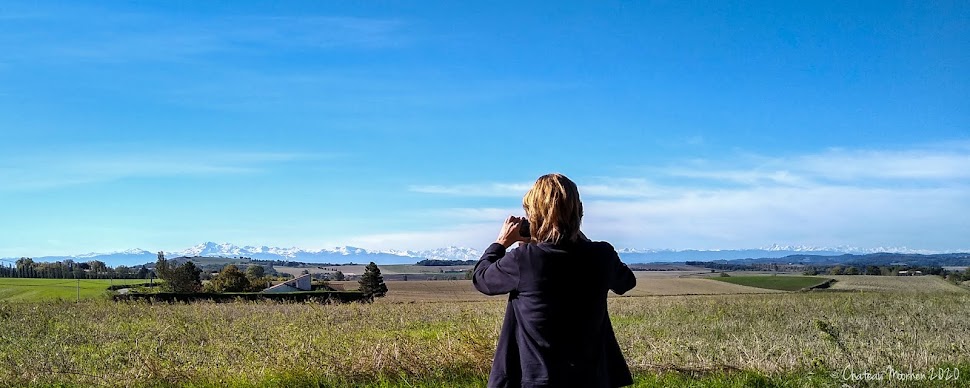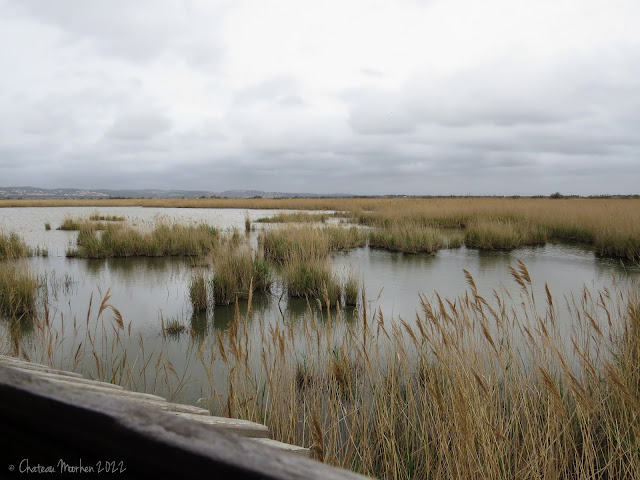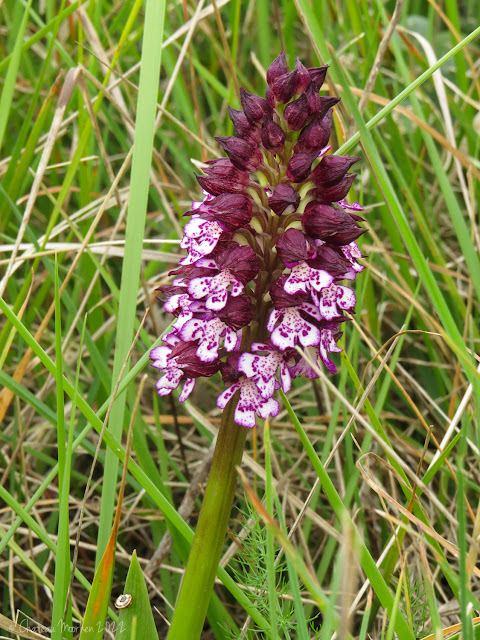We started off at Le Grand Castelou, which is the wetland reserve I posted about a few months back where K and I visited at the end of December. It's a marshland area bordering on the Etang de Bages and has White Storks nesting there.
This hide is really badly designed (obviously not by a birder!) as the windows are far too narrow giving you only a small view and they are all at different heights, and the benches are suited only for kids to sit on them anyway. With a group of people it means there's always someone who can't see out properly, especially if there is something of interest to see. I'm surprised as it's a nature reserve within the Parc Naturel Régionale de la Narbonnaise en Mediterannéé, who I think should know better. 😞
We were still too early for Reed Warblers but there was still plenty of bird life around. Cetti's Warbler let us know it was around at the top of its voice, but as usual didn't show itself. We did get a distant glimpse of a Sardininan Warbler and a Yellow Wagtail. I have been learning that there are many subspecies of Yellow Wagtail (Motacilla flava) but one that is commonly seen around these coastal areas is the Spanish one, M. flava iberiae, which has a white chin and white supercilium (eye stripe).
Photo credit: Keith Allen
Sardinian Warbler (Curruca melanocephala) Note the red eye! You might need to click on the image to bring it up larger to see properly, ditto the one above.
Photo credit: Keith Allen
Here we are by the side of a little water channel looking for the something special I mentioned up above.....
It's a Mediterranean Tree Frog (Hyla meridionalis)! I had never seen one before so it was a lovely surprise. They are so cute! Karline, our guide, knows what she is doing and how to hold creatures properly so she caught one for us to have a better look.
There's a colony of White Stork which nest here.
Photo credit: Keith Allen
We then moved on to a different habitat on the Ile St Martin, wandering through the vineyards, with attractive cliffs to one side and a view of Etang de Bages on another side.
It's such a shame the weather wasn't better. The sun did try to come out here, which warmed us up a little bit, and a few white butterflies emerged. but that was about it.
This next photo shows some white flowers in the foreground between the vines. This is Diplotaxis erucoides, a western Mediterranean species known as False Rocket in France, and flowers all through the winter, particularly in the vineyards! I don't know why it likes vineyards so much, but it does add a bit of interest to the countryside as you are driving around in the winter. The leaves are edible, although you need to wait for some young shoots in the spring as there's not much leaf growth in the winter. This vineyard has been well weeded though - usually narrow tractors go through the vines grubbing out the weeds. I noticed the amount of pollinating insects all over it - so an extremely useful plant for insects which emerge early in the year when there aren't many flowers around.
Looking back the way we came there was a lovely view of Gruissan, on the Etang de Bages. We visited last September with my brother, including going up to this tower, the Tour Barberousse.
Below is a Lady Orchid (Orchis purpurea).
In a couple of places around here the group went out onto the salt pans to see what birds could be found, but it just got windier and windier and I went back to the car (and I wasn't the only person!). The group didn't find much as the birds were obviously hunkered down somewhere more sheltered!
There was a lot of this sea foam around, I guess it's the wind that whips it up like this. I find it fascinating although a bit yukky too!
I did see these Avocets before heading back to the warmth of the car!
Photo credit: Keith Allen
At the end of the day we headed to this disused quarry at the base of La Clape, a small limestone range that runs between Narbonne and the sea. This plant stood out for me, and on closer inspection it looked very pretty. We later discovered that it is Amelanchier ovalis, known in English most often as Snowy Mespilus. In the autumn it has beautiful leaf colours and the leaves look not dissimilar to the Smoke Bush. It also has berries that birds love, sounds like a really good tree to have in a garden. 😀
Last, but definitely not least. The reason that we came to this quarry - the Blue Rock Thrush! They seem to love old quarries and are easy to spot as they seem to like the very top where they are silhouetted against the sky. Luckily this one came down in front of the rocks so it's colour could be seen. However, it was still rather far away so even Keith's zoom lens couldn't do better than this, and the image is heavily cropped!
Photo credit: Keith Allen
We have since been on another trip with BL, and we have two more booked up in May. They are exhausting though - the most recent one we had to leave at 6.30am!! When we get home about 12 hours later we are wrecked. 😀😁😀





































